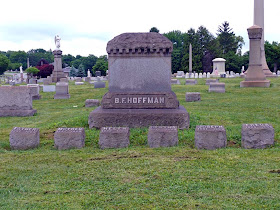 As we slowly travel westward, we've decided to spend a week visiting the recreational vehicle capital of the world, Elkhart, Indiana, along with South Bend and the surrounding region. It's a pretty area, with fields of corn and soybeans broken by hardwood forests and small lakes. We're staying in a very nice park in Niles, Michigan, just across the Indiana line, and along with exploring, we're catching up on fixing the
As we slowly travel westward, we've decided to spend a week visiting the recreational vehicle capital of the world, Elkhart, Indiana, along with South Bend and the surrounding region. It's a pretty area, with fields of corn and soybeans broken by hardwood forests and small lakes. We're staying in a very nice park in Niles, Michigan, just across the Indiana line, and along with exploring, we're catching up on fixing the little things that crop up on a home that does 60 MPH over rough roads. Our first visit was to the Recreational Vehicle/Motor Home Hall of Fame Museum, housed in a beautiful new building right off the interstate highway and with big-rig parking if you're just passing through. Although we tend to think that the building of RVs started with the iconic Winnebago, we found that as soon as the automobile was built, people wanted travel trailers to pull behind them. Especially interesting was this 1913 travel trailer.
little things that crop up on a home that does 60 MPH over rough roads. Our first visit was to the Recreational Vehicle/Motor Home Hall of Fame Museum, housed in a beautiful new building right off the interstate highway and with big-rig parking if you're just passing through. Although we tend to think that the building of RVs started with the iconic Winnebago, we found that as soon as the automobile was built, people wanted travel trailers to pull behind them. Especially interesting was this 1913 travel trailer.  The workmanship was beautiful, and the interior, with it's hardwood floors and cabinets was stunning even after all these years.
The workmanship was beautiful, and the interior, with it's hardwood floors and cabinets was stunning even after all these years. 
 There were also a number of "house cars", the first motor homes, and this 1930's "Tennessee Traveler" even featured a
There were also a number of "house cars", the first motor homes, and this 1930's "Tennessee Traveler" even featured a  wood-burning stove in the kitchen! Our favorite was Mae West's 1931 house car that was built to entice her to move from New York to make movies on the west coast; you can see a picture of it here.
wood-burning stove in the kitchen! Our favorite was Mae West's 1931 house car that was built to entice her to move from New York to make movies on the west coast; you can see a picture of it here.  Some of the older models showed a glimpse of what was to come, like this "Silver Bullet". As you wander through the museum exhibits, the models get newer and more sophisticated, there's a 1976 Cadillac conversion, the revolutionary GMC Motorhome, and a 70s-era Winnebago Brave. If you're an RV owner or interested in RVs, this is a great place to visit and see how the industry has changed over the years.
Some of the older models showed a glimpse of what was to come, like this "Silver Bullet". As you wander through the museum exhibits, the models get newer and more sophisticated, there's a 1976 Cadillac conversion, the revolutionary GMC Motorhome, and a 70s-era Winnebago Brave. If you're an RV owner or interested in RVs, this is a great place to visit and see how the industry has changed over the years.When we were shopping for our first motorhome, we visited this area to tour the different manufacturer's plants to learn how they were made. One of our visits was to Wakarusa and the Monaco Plant. When we visited six years ago, the plant was a beehive of activity; nearly 1000 workers were producing Monaco and Holiday Rambler motorhomes and travel trailers.
 Today, Monaco has ceased operations and the plant is closed - weeds are growing up through the concrete where hundreds of RVs sat waiting for delivery, and as you drive around the area, you can see that supporting businesses that made mattresses, countertops, etc., for the plant have also closed or are only partially open. Reading that unemployment in the region is approaching 20% is a number that's hard to imagine; but seeing such a large manufacturing area closed up hits you with the realization of
Today, Monaco has ceased operations and the plant is closed - weeds are growing up through the concrete where hundreds of RVs sat waiting for delivery, and as you drive around the area, you can see that supporting businesses that made mattresses, countertops, etc., for the plant have also closed or are only partially open. Reading that unemployment in the region is approaching 20% is a number that's hard to imagine; but seeing such a large manufacturing area closed up hits you with the realization of  how tough times are for people here. Unfortunately, Monaco has filed Chapter 7 and is probably gone as a manufacturer, and while another company has bought some of the assets, it's doubtful that this area will ever see the plant reopen. It's a sad time for many of the area's residents and we hope they'll be able to recover.
how tough times are for people here. Unfortunately, Monaco has filed Chapter 7 and is probably gone as a manufacturer, and while another company has bought some of the assets, it's doubtful that this area will ever see the plant reopen. It's a sad time for many of the area's residents and we hope they'll be able to recover.We'll be here for a few more days and plan to do more exploring; come back and visit!







